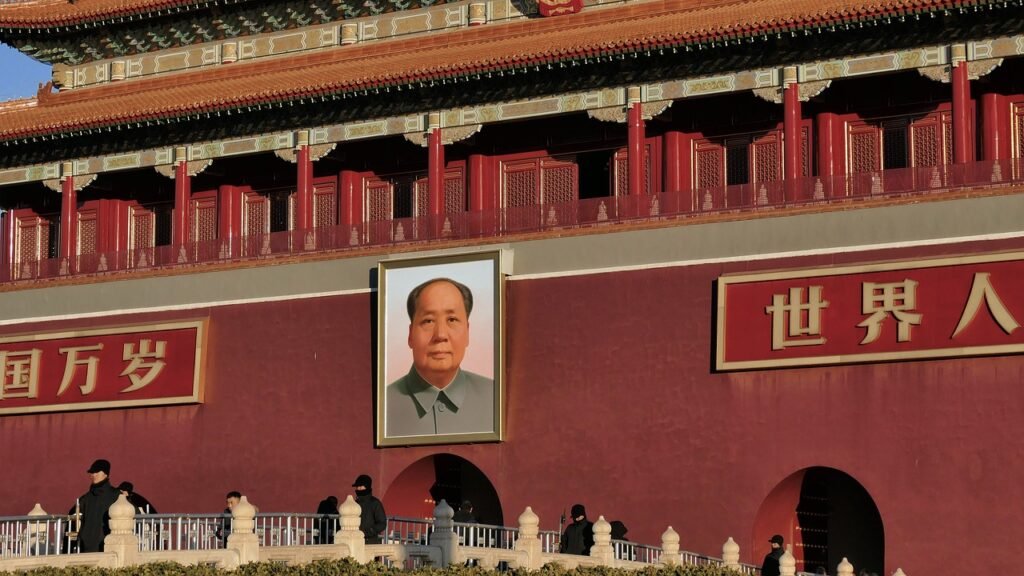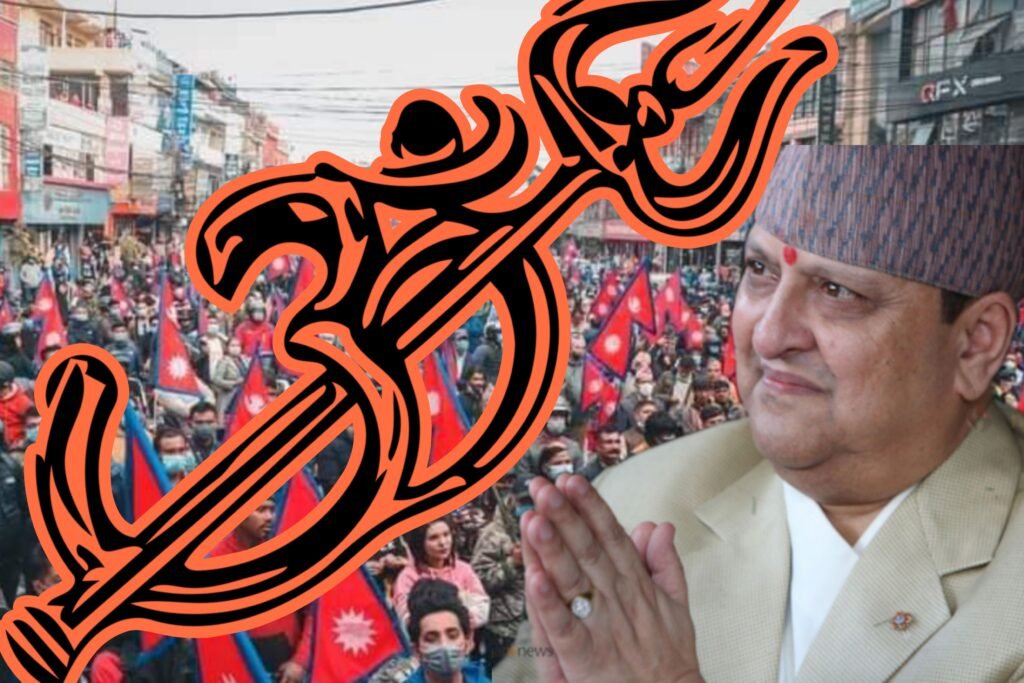Nepal, only Hindu Rashtra in the World before 2008, nestled in the lap of the Himalayas, has a rich cultural and religious heritage that has shaped its identity over centuries.
For almost one decade (1996-2008) Nepal endured a civil war between the Monarchy and Maoist groups, which resulted in the transformation of Nepal from a Hindu Rashtra to a secular state.
Recently, the demand for the restoration of monarchy and a Hindu State has grappled the Nepal’s politics. In this blog, we will dive into the history of the Nepal Kingdom, the shift to secularism, the rise of Maoism in Nepal, the role of China and why Hindu Nepal is in India’s interest.
Table of Contents
kingdom of Nepal
The modern-day Kingdom of Nepal was established in 1768 by King Prithvi Narayan Shah, a Gorkha monarch. Similar to other kingdoms worldwide, Nepal experienced internal strife marked by family conspiracies and opposition from the people.
While the position of the king was hereditary, the executive head of state changed hands among various families and regimes over two centuries. Notably, the Pande regime, Thapa regime, and Rana regime played pivotal roles in Nepal’s political landscape.
Damodar Pande
Damodar Pande, appointed as one of the Kajis by King Rana Bahadur Shah, became a central figure during a period of civil unrest caused by Rana Bahadur Shah’s erratic behaviour. Damodar Pande emerged as a prominent leader of the opposition. However, his execution led to the appointment of Ranajit Pande as Mulkaji and Bhimsen Thapa as the second Kaji.
Thapa Regime
During the Thapa regime, King Rana Bahadur Shah was murdered by his half-brother Sher Bahadur Shah. Bhimsen Thapa capitalized on the situation, orchestrating the massacre of 55 military and civil officers to seize power. He assumed the title of Mukhtiyar, becoming the executive head of the state.
Rana Regime
In 1846, Queen Rajya Lakshmi Devi conspired to overthrow Jang Bahadur Rana, a rising military leader posing a threat to her power. The Kot massacre on September 14, 1846, witnessed Jang Bahadur and his brothers killing 40 civil and military guards of the palace, including the executive head of state (Prime Minister) of Nepal. Jang Bahadur emerged victorious, establishing the Rana dynasty. The monarchy was relegated to a ceremonial figurehead, while the Prime Minister, a position held by the Ranas, became powerful and hereditary.
Journey towards secularism
Widespread discontent arose against the Ranas among the educated populace, within the Rana family, and among Nepali exiles. Rana executed numerous dissidents, and many sacrificed their lives for the cause of liberation. King Tribhuvan, a direct descendant of Prithvi Narayan Shah, escaped from his palace prison to India. With the assistance of India, he successfully overthrew the Rana regime in 1951 and appointed a non-Rana Prime Minister.
A quasi-constitutional rule was instituted, wherein the monarch was aided by dissatisfied leaders of political parties. As the demand for greater inclusivity and representation increased, King Mahendra, Tribhuvan’s son, issued a new constitution in 1959, followed by the first democratic elections. The Nepali Congress party emerged victorious, but this experiment was short-lived. In 1960, a power struggle between the monarch and the elected government led to Mahendra dismissing the elected government.
In 1962, King Mahendra introduced the partyless Panchayat system to govern Nepal, a pyramidal structure with village assemblies at the bottom and Rashtriya Panchayat at the top. This system vested absolute power in the King, placing all state institutions under his control. The concentration of power in the hands of the King, coupled with the non-representative nature of the palace and restrictions on political parties, fuelled dissatisfaction among the people.
Simultaneously, India-Nepal relations deteriorated due to unfavourable measures such as Indian work permits, the revocation of duty concessions on Indian goods, and the purchase of weapons from China in 1988. These actions added to the discontent of political parties. The Nepali Congress party and the United Left Front (ULF) intensified the atmosphere of resentment, culminating in a massive protest on February 18, 1990, which compelled the King to dismantle the Panchayat system
secular Nepal
The Nepali Congress, with the backing of the “Alliance of Leftist Parties,” opted to initiate a decisive agitational movement called ‘Jana Andolan.’ This movement compelled the monarchy to embrace constitutional reforms and establish a multiparty parliament. In May 1991, Nepal conducted its first parliamentary elections in nearly five decades, resulting in the Nepali Congress party forming the government with a majority.
By 1992, an economic crisis marked by high inflation, attributed to the policies of the Nepali Congress government, provided an opening for a political agitation inspired by Maoism. In February 1996, Maoist parties launched a campaign to overthrow the monarchy and establish a people’s republic using a revolutionary strategy known as the people’s war, leading to the Nepalese Civil War. The Maoists proclaimed a provisional people’s government at the district level, sparking nationwide conflict between the Nepali government and Maoist parties.
On June 1, 2001, Crown Prince Dipendra shot and killed nine members of the royal family, including King Birendra and Queen Aishwarya, before taking his own life. Prince Gyanendra ascended to the throne. Simultaneously, the Maoist rebellion intensified, prompting the King to temporarily depose the government in October 2002 and assume control. A week later, he appointed a new government.
Faced with an unstable government and a Maoist siege on the Kathmandu valley in August 2004, Gyanendra, on February 1, 2005, dismissed the government and assumed all executive powers, declaring a state of emergency to thwart the Maoist revolution. In April 2006, protests and street demonstrations in Kathmandu compelled the King to reinstate the Parliament. A seven-party coalition regained control of the government, leading to the signing of the Comprehensive Peace Accord between the King and the Maoists on November 21, 2006.
The Constituent Assembly materialized on December 24, 2007, with the announcement that the monarchy would be abolished in 2008 after the constituent assembly elections. On May 28, 2008, Nepal was declared a ‘Federal Democratic Republic.
Rise of Maoism in Nepal

The Maoist insurgents adhered to the ideology of revolution, seeking political change through violent means to establish a government for the people. Factors such as poor governance, corruption, political instability, and inflation served as key catalysts for the rise of Maoism in Nepal. The Communist Party of Nepal (Maoist), established in 1994, gained prominence for initiating the ‘People’s War,’ a decade-long Civil War.
Initially, suspicions arose regarding China’s potential support for the Nepalese Maoists, but China refuted these claims, labelling the rebels as terrorists. In 2002, China’s President, Jiang Zemin, expressed support for King Gyanendra and the Nepali government’s efforts to suppress armed anti-government forces. However, China may have adopted a dual stance, as it maintained friendly relations with Nepalese communist parties after 2008.
To sustain their rebellion, Maoists in Nepal engaged in bank robberies, tax collections, donations, extortion, and looting weapons from police stations. This insurgency provided marginalized groups such as Dalits, women, the landless, and ethnic and indigenous communities with some political space. Consequently, communist parties in Nepal garnered significant support from the marginalized population, particularly in the Tarai region over the years.
why demand for hindu rashtra now?
In 2023, there were frequent rallies demanding the restoration of the Monarchy and the establishment of a Hindu Rashtra in Nepal. In November, the “Rashtra, Rashtriyata, Dharma-Sanskriti Aur Nagarik Bachau Andolan” garnered support from numerous Nepalese, marking one of the largest rallies advocating for a Hindu Rashtra to date.
However, the sudden surge in the demand for a Hindu Rashtra in Nepal can be attributed to several reasons. Firstly, political instability in the country has resulted in widespread issues such as acute unemployment, inflation, poor governance, and a financial crisis. Secondly, a significant number of people have fallen victim to financial wrongdoing by cooperatives and financial companies closely connected to politicians. Thirdly, the Hindu population in the country views the King as a living embodiment of Bhagwan Vishnu, while Christians and Muslim evangelists are reportedly converting Hindus in Nepal, taking advantage of their economic challenges.
The Rashtriya Prajatantra Party (RPP) and Nepal Janata Party (NJP) are actively advocating for a Hindu State and the restoration of the Monarchy, with their rallies gaining increasing momentum. In February 2023, King Gyanendra’s public engagements garnered substantial support, notably seen when he unveiled a statue of King Prithvi Narayan Shah, the founder of Modern Nepal.
Good for india
China’s sway over Nepal experienced significant growth after 2008, fueled by the alignment of like-minded communist parties in both nations. Nepal’s involvement in China’s ambitious Belt and Road Initiative (BRI), which includes the China Pakistan Economic Corridor passing through Pakistan-occupied Kashmir, further solidified this influence. The hardening of Nepal’s stance against Tibetan refugees, numbering around 20,000, is exacerbated by China’s increasing dominance in Nepal, leading to a more challenging life for the refugees.
Nepal’s deepening connection with China grants the latter strategic leverage in South Asia, enabling potential influence beyond national borders. Recent years have witnessed strained India-Nepal relations, particularly during K.P Oli’s tenure as Nepal’s Prime Minister, marked by significant Chinese influence. Oli’s administration claimed Indian territories of Kalapani, Limpiyadhura, and Lipulekh, intensifying border deployments and causing prolonged disruptions in bilateral relations. Oli’s controversial assertion that Lord Rama was born in Nepal added to the complexities.
Given these circumstances, a reduction in the power of communist parties and the restoration of the Hindu monarchy in Nepal would align with India’s interests. While this change may not be immediate, there is hope that it will materialize in the near future.
